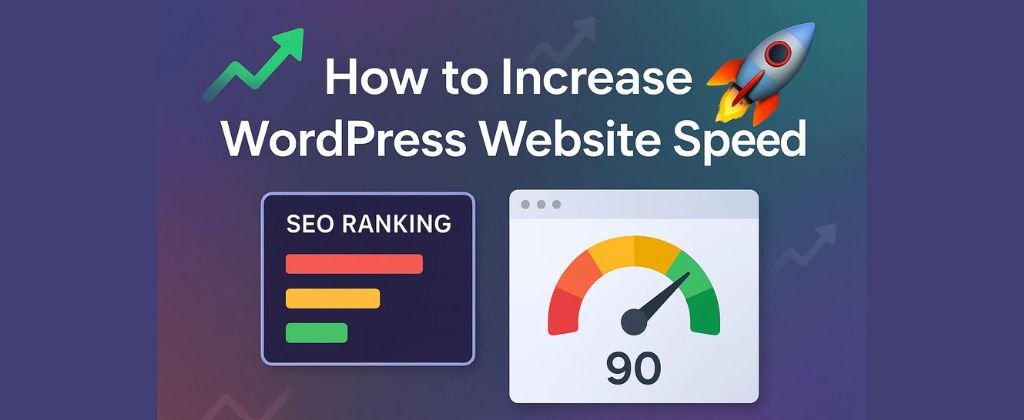In today’s digital world, the speed of your website plays a big role in online success. A slow website can drive your visitors away and affect your SEO ranking. If you are running a WordPress website, then knowing how to increase WordPress website speed becomes very important.
Many website owners in India are unaware that slow-loading websites not only reduce traffic but also decrease user satisfaction. Before we learn how to boost the speed, let’s understand why website speed gets affected and how to fix it using simple methods in normal Indian English.
🎯 Why Website Speed is Affected
There are many reasons why a WordPress website becomes slow. Let’s look at the most common causes:
- Heavy Images: If your website uses high-resolution images that are not compressed, it takes a lot of time to load.
- Too Many Plugins: Installing unnecessary or poorly coded plugins can affect the speed of your site.
- Poor Hosting Service: A low-quality or shared hosting plan slows down your website’s performance.
- Unoptimized Theme: Some themes have a lot of built-in features which you might not use, but they increase load time.
- Lack of Caching: Without caching, your server has to load every page again and again which takes time.
- No Content Delivery Network (CDN): If you don’t use a CDN, your website loads slower for users who are far from your server’s location.
- Unminified CSS, JS Files: If your code files are too large or messy, they make your website heavier and slower.
Now that we know the problems, let’s move towards the solution — how to increase WordPress website speed.
🎯 Best Ways to Increase WordPress Website Speed
Here are some simple yet effective ways you can use to speed up your WordPress website.
✅ 1. Choose a Good Hosting Provider
Your hosting service is the foundation of your website. Always go for reliable WordPress hosting providers like Hostinger, SiteGround, or Bluehost. Avoid cheap hosting plans that put your site on a shared server with hundreds of other websites.
✅ 2. Use Lightweight and Fast Themes
Avoid themes that look fancy but are bloated with features you don’t need. Use lightweight themes like Astra, GeneratePress, or Neve which are made for speed.
✅ 3. Compress and Optimize Images
Large image sizes are one of the biggest reasons behind a slow website. Use free plugins like Smush or ShortPixel to automatically compress images without losing quality. You can also use WebP image format which is lighter than JPEG or PNG.
✅ 4. Install a Caching Plugin
Caching helps reduce load time by storing static versions of your web pages. Popular caching plugins like W3 Total Cache, WP Super Cache, or LiteSpeed Cache are very useful.
✅ 5. Minify CSS, JavaScript, and HTML Files
Minifying means removing unnecessary characters, spaces, and lines from your code files. You can use plugins like Autoptimize or Fast Velocity Minify to do this easily.
✅ 6. Use a Content Delivery Network (CDN)
A CDN stores copies of your website content in different locations around the world. So when someone opens your site, they get the content from the nearest server, which reduces loading time. Cloudflare and BunnyCDN are great options.
✅ 7. Remove Unused Plugins and Themes
Only keep the plugins and themes that you are using. Delete the rest. Unused themes and plugins can affect performance and even pose security risks.
✅ 8. Limit Post Revisions and Clean Database
WordPress saves every version of your posts, which increases your database size. You can use WP-Optimize or Advanced Database Cleaner to clean your database and limit post revisions.
✅ 9. Enable GZIP Compression
GZIP compresses your website files and makes them smaller, so they load faster in the user’s browser. Most caching plugins offer this feature.
✅ 10. Disable Hotlinking
Hotlinking means other websites are using your images and loading them from your server. This increases your server load. You can disable hotlinking by adding a small code in your .htaccess file or using security plugins like All In One WP Security.
✅ 11. Update WordPress, Themes, and Plugins
Always keep your WordPress core, plugins, and themes updated. Developers regularly improve performance and security with updates.
✅ 12. Use Lazy Loading
Lazy loading delays the loading of images and videos until they are visible to the user. This reduces the initial load time of your web page. Plugins like Lazy Load by WP Rocket help you do this easily.
✅ 13. Monitor Website Speed Regularly
Keep an eye on your website performance using tools like Google PageSpeed Insights, GTmetrix, or Pingdom. These tools also give you suggestions on how to improve speed.
✅ 14. Reduce External Scripts
External scripts like Google Fonts, ads, or social media feeds can slow down your site. Use them only when necessary, and try to host fonts locally.
✅ 15. Avoid Redirect Chains
Too many redirects confuse the browser and delay page loading. Make sure URLs redirect properly and only when needed.
Final Thoughts on Website Speed
A fast website is not a luxury—it’s a necessity in today’s digital age. Whether you’re running a blog, e-commerce site, or portfolio, website speed affects everything—from user experience to search engine rankings. By following these simple tips and understanding why website speed is affected, you can dramatically improve your WordPress website’s performance.
Even if you’re not a technical expert, most of the above steps are easy to do with free plugins and some basic understanding. Always test your website after making changes and track improvements over time.


Leave A Comment